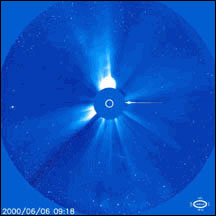|
Fast-moving solar eruptions that
overtake and devour their slower-moving kin can trigger long-lasting
geomagnetic storms when they strike Earth's magnetosphere.
 |
 |
| A coronagraph on board the ESA-NASA
SOHO spacecraft captured this example of CME cannibalism
in action on June 6, 2000. (Click
for a larger image.) |
|
March 27, 2001
— Fast-moving solar eruptions apparently
overtake and often devour their slower-moving kin. This discovery
was made by a team of astronomers working with a pair of NASA spacecraft.
Strange radio fireworks were first heard by the team using NASA's
Wind spacecraft. The link to the cosmic collisions came when researchers
matched the timing of the radio outbursts to images of solar eruptions
consuming each other. The dynamic pictures of the so-called "cannibal
coronal mass ejections" were captured by the Solar and Heliospheric
Observatory (SOHO) spacecraft from NASA and the European Space Agency
(ESA).
Solar eruptions directed toward Earth are potentially harmful to
advanced technology, including communications and power systems,
and this "cannibalistic" behavior may result in longer
magnetic storms. These collisions change the speed of the eruption,
which is important for space weather prediction because it alters
the estimated arrival time of Earthbound coronal mass ejections
(CMEs).
"Coronal mass ejection cannibalism is the most violent form
of interaction between CMEs," says NASA Goddard's Dr. Natchimuthuk
Gopalswamy, lead author of a research paper presented during a meeting
of the European Geophysical Society in Nice, France. "This
happens when a slow CME is expelled before a fast one from the same
general region on the Sun. The fast CME simply gobbles up the slow
one," resulting in a single, complex outward-moving front.
Coronal mass ejections are billion-ton clouds of electrified, magnetic
gas that solar eruptions hurl into space at speeds ranging from
a few hundred to 2000 km/s. Earth-directed CMEs can trigger magnetic
storms when they strike our planet's magnetic field, distorting
its shape and accelerating electrically charged particles trapped
within. The researchers believe cannibal eruptions may be larger
and more complex in structure than typical eruptions. These traits
cause "complex ejecta" CMEs to trigger protracted magnetic
storms when they envelop the Earth.
The Coronal Mass Ejections continues in PDF
form:
 View the Coronal
Mass Ejections in PDF form.
View the Coronal
Mass Ejections in PDF form.
 Questions
about reading PDFs? See the Help page
on this CD for details. Questions
about reading PDFs? See the Help page
on this CD for details.
The Coronal Mass Ejections continues on the Web:
 View
Coronal
Mass Ejections Web site at science.nasa.gov.
View
Coronal
Mass Ejections Web site at science.nasa.gov.
Additional Resources:
 Learn more about NASA's
Wind spacecraft.
Learn more about NASA's
Wind spacecraft.
 Learn more
about the Solar
and Heliospheric Observatory (SOHO) spacecraft from NASA and
the European Space Agency (ESA).
Learn more
about the Solar
and Heliospheric Observatory (SOHO) spacecraft from NASA and
the European Space Agency (ESA).
|
